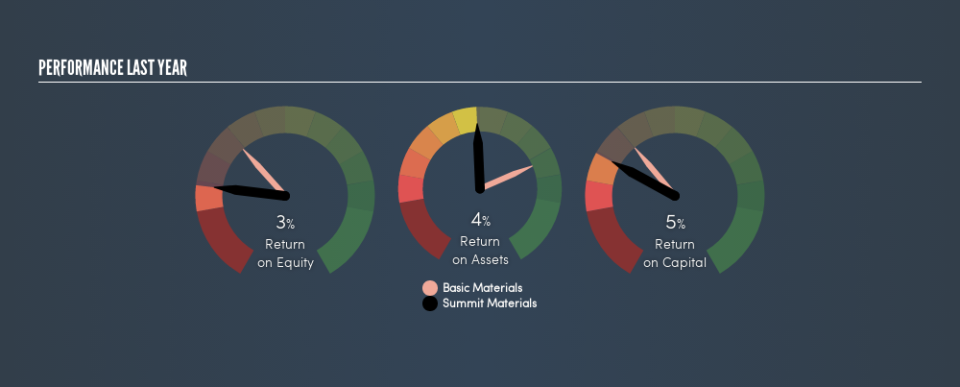Why Summit Materials, Inc.’s (NYSE:SUM) Use Of Investor Capital Doesn’t Look Great

Want to participate in a short research study? Help shape the future of investing tools and you could win a $250 gift card!
Today we'll evaluate Summit Materials, Inc. (NYSE:SUM) to determine whether it could have potential as an investment idea. In particular, we'll consider its Return On Capital Employed (ROCE), as that can give us insight into how profitably the company is able to employ capital in its business.
First up, we'll look at what ROCE is and how we calculate it. Second, we'll look at its ROCE compared to similar companies. Finally, we'll look at how its current liabilities affect its ROCE.
Return On Capital Employed (ROCE): What is it?
ROCE is a metric for evaluating how much pre-tax income (in percentage terms) a company earns on the capital invested in its business. In general, businesses with a higher ROCE are usually better quality. In brief, it is a useful tool, but it is not without drawbacks. Author Edwin Whiting says to be careful when comparing the ROCE of different businesses, since 'No two businesses are exactly alike.'
So, How Do We Calculate ROCE?
Analysts use this formula to calculate return on capital employed:
Return on Capital Employed = Earnings Before Interest and Tax (EBIT) ÷ (Total Assets - Current Liabilities)
Or for Summit Materials:
0.046 = US$167m ÷ (US$3.9b - US$261m) (Based on the trailing twelve months to December 2018.)
Therefore, Summit Materials has an ROCE of 4.6%.
View our latest analysis for Summit Materials
Does Summit Materials Have A Good ROCE?
ROCE can be useful when making comparisons, such as between similar companies. Using our data, Summit Materials's ROCE appears to be significantly below the 8.5% average in the Basic Materials industry. This performance could be negative if sustained, as it suggests the business may underperform its industry. Independently of how Summit Materials compares to its industry, its ROCE in absolute terms is low; especially compared to the ~2.7% available in government bonds. Readers may wish to look for more rewarding investments.
Summit Materials's current ROCE of 4.6% is lower than 3 years ago, when the company reported a 7.2% ROCE. This makes us wonder if the business is facing new challenges.
When considering ROCE, bear in mind that it reflects the past and does not necessarily predict the future. ROCE can be misleading for companies in cyclical industries, with returns looking impressive during the boom times, but very weak during the busts. ROCE is only a point-in-time measure. What happens in the future is pretty important for investors, so we have prepared a free report on analyst forecasts for Summit Materials.
How Summit Materials's Current Liabilities Impact Its ROCE
Current liabilities are short term bills and invoices that need to be paid in 12 months or less. Due to the way the ROCE equation works, having large bills due in the near term can make it look as though a company has less capital employed, and thus a higher ROCE than usual. To counteract this, we check if a company has high current liabilities, relative to its total assets.
Summit Materials has total liabilities of US$261m and total assets of US$3.9b. As a result, its current liabilities are equal to approximately 6.8% of its total assets. With barely any current liabilities, there is minimal impact on Summit Materials's admittedly low ROCE.
The Bottom Line On Summit Materials's ROCE
Nonetheless, there may be better places to invest your capital. Of course, you might also be able to find a better stock than Summit Materials. So you may wish to see this free collection of other companies that have grown earnings strongly.
If you are like me, then you will not want to miss this free list of growing companies that insiders are buying.
We aim to bring you long-term focused research analysis driven by fundamental data. Note that our analysis may not factor in the latest price-sensitive company announcements or qualitative material.
If you spot an error that warrants correction, please contact the editor at editorial-team@simplywallst.com. This article by Simply Wall St is general in nature. It does not constitute a recommendation to buy or sell any stock, and does not take account of your objectives, or your financial situation. Simply Wall St has no position in the stocks mentioned. Thank you for reading.

